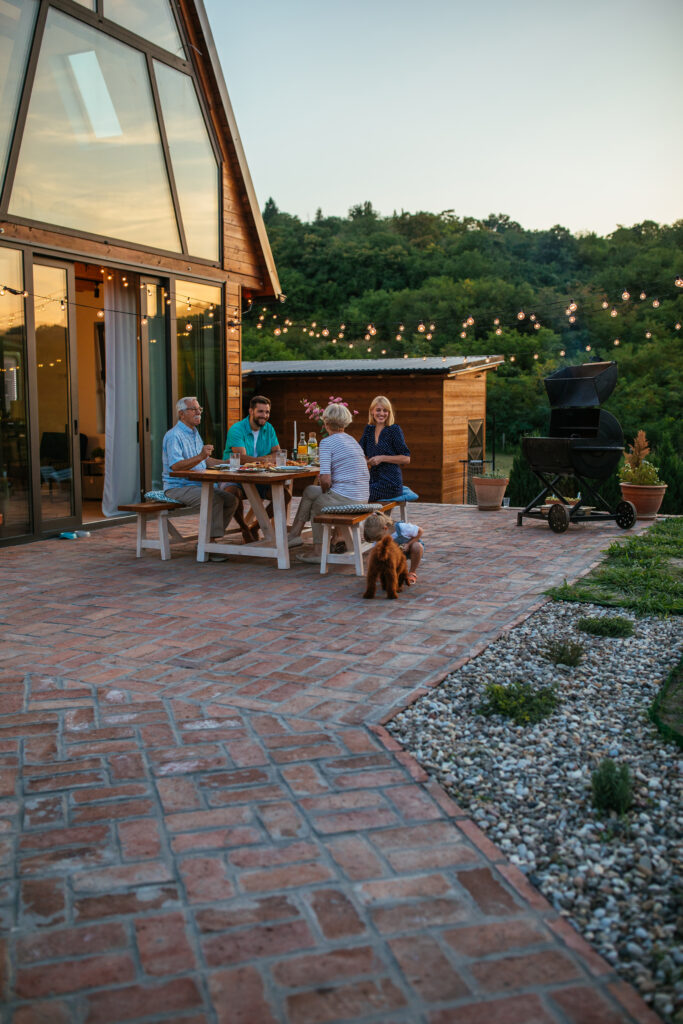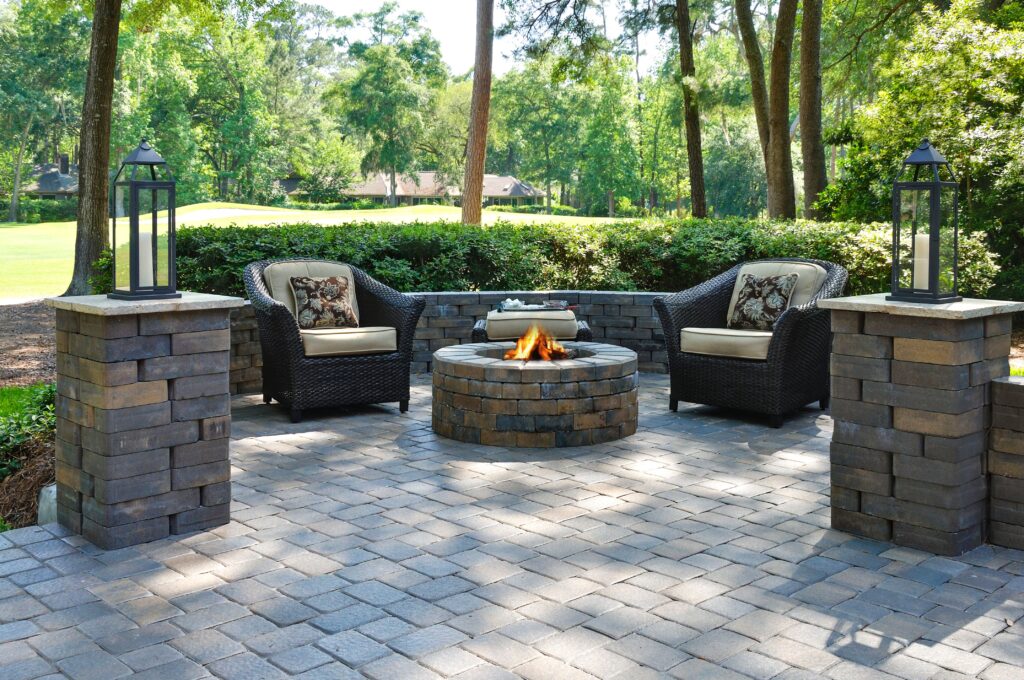The Ultimate Guide to Choosing the Right Pavers for Your Patio
Brought to You by Creative Outdoor Design
Deciding on Your Patio Pavers
Choosing the right pavers for your patio is a crucial decision that can significantly impact the aesthetics, functionality, and longevity of your outdoor space. With so many options available, it can be overwhelming to decide which type of paver will best suit your needs. This comprehensive guide will help you navigate through the various paver materials, cost considerations, design elements, installation tips, and maintenance requirements to ensure you make an informed decision for your patio project.
Understanding Paver Materials
The first step in choosing the right pavers is understanding the different materials available and their respective advantages and disadvantages. Here’s a detailed look at some of the most popular options:
Brick Pavers
- Pros: Brick pavers are known for their classic, timeless look and durability. They are resistant to staining and require minimal maintenance. Additionally, brick pavers are environmentally friendly as they can be recycled and reused.
- Cons: Brick pavers can be more expensive than other materials and may crack or chip over time. They are also limited in color options, typically available in shades of red, brown, and tan.
- Ideal Use: Perfect for traditional or historic homes, brick pavers add a touch of elegance and sophistication to any patio.
Concrete Pavers
- Pros: Concrete pavers are versatile and come in a wide variety of shapes, sizes, colors, and textures. They are cost-effective and easy to install, making them a popular choice for many homeowners.
- Cons: Concrete pavers can fade over time and may require sealing to maintain their appearance. They are also susceptible to cracking in extreme weather conditions.
- Ideal Use: Suitable for modern and contemporary designs, concrete pavers offer flexibility in design and can mimic the look of natural stone at a lower cost.
Natural Stone Pavers
- Pros: Natural stone pavers, such as granite, slate, limestone, and travertine, offer unmatched beauty and a unique, luxurious look. Each stone is unique, providing a one-of-a-kind appearance for your patio.
- Cons: Natural stone can be expensive and may require professional installation. Some types of stone can be porous and require sealing to prevent staining and weather damage.
- Ideal Use: Ideal for upscale homes and properties, natural stone pavers create a stunning, high-end look that is both durable and timeless.
Porcelain Pavers
- Pros: Porcelain pavers are highly durable, resistant to staining, fading, and scratching. They are also low-maintenance and available in a variety of colors and textures, often mimicking the look of natural stone or wood.
- Cons: Porcelain pavers can be more expensive than other options and may require a professional installation to ensure proper placement and stability.
- Ideal Use: Perfect for sleek, modern designs, porcelain pavers offer a high-end look with the added benefit of easy maintenance.

Paver Patios Installed by Creative Outdoor Design
Cost vs. Longevity
When selecting pavers, it’s essential to consider the balance between cost and longevity. Here’s a breakdown of what to expect with each material:
- Brick Pavers: Generally priced higher than concrete but lower than natural stone, brick pavers offer a good balance of cost and durability. They can last for decades with minimal maintenance.
- Concrete Pavers: Typically the most affordable option, concrete pavers provide excellent value for money. While they may not last as long as brick or natural stone, proper installation and maintenance can extend their lifespan.
- Natural Stone Pavers: The most expensive option, natural stone pavers offer unparalleled beauty and durability. With proper care, they can last a lifetime, making them a worthwhile investment for those seeking a high-end finish.
- Porcelain Pavers: Porcelain pavers are on the higher end of the price spectrum but offer excellent longevity and low maintenance, making them a cost-effective option over time.
Design Considerations
Choosing the right pavers also involves considering the overall design and aesthetic of your patio. Here are some key design elements to keep in mind:
- Color Scheme:
- Choose pavers that complement the exterior of your home and the surrounding landscape. Neutral colors like gray, beige, and taupe are versatile and blend well with various design styles, while bolder colors can create a striking focal point.
- Shape and Size:
- The shape and size of your pavers can dramatically impact the look of your patio. Large pavers can create a modern, streamlined appearance, while smaller, irregularly shaped pavers lend a more rustic, traditional feel.
- Pattern:
- Consider the pattern in which the pavers will be laid. Popular patterns include herringbone, basket weave, and running bond. Each pattern has its own unique look and can influence the overall aesthetic of your patio.
- Texture:
- The texture of the pavers can add depth and interest to your patio design. Smooth pavers create a sleek, contemporary look, while textured or tumbled pavers add a more natural, weathered appearance.
- Color Scheme:





Installation Tips
Proper installation is crucial for the longevity and appearance of your patio. Here are some installation tips to ensure your project is successful:
- Prepare the Ground:
- Excavate the area to a depth of 6-8 inches, removing any grass, roots, or debris. Ensure the ground is level and compacted to provide a stable base for the pavers.
- Install a Base Layer:
- Lay a 4-6 inch layer of crushed stone or gravel as a base, compacting it thoroughly to create a solid foundation. This layer helps with drainage and prevents the pavers from shifting.
- Add a Sand Layer:
- Spread a 1-inch layer of coarse sand over the base layer, leveling it with a screed board. The sand provides a smooth surface for laying the pavers and helps to lock them in place.
- Lay the Pavers:
- Begin laying the pavers in your desired pattern, starting from one corner and working your way across the area. Use spacers to ensure even gaps between the pavers and adjust as needed to maintain a level surface.
- Compact the Pavers:
- Once all the pavers are in place, use a plate compactor to settle them into the sand layer. This step ensures the pavers are firmly set and reduces the risk of shifting over time.
- Fill the Joints:
- Sweep sand or polymeric sand into the joints between the pavers, ensuring all gaps are filled. The sand helps to lock the pavers in place and prevent weed growth.
- Seal the Pavers:
- Consider sealing your pavers to protect them from stains, weather damage, and fading. Sealing can also enhance the color and texture of the pavers, giving your patio a polished, finished look.
Maintenance
Regular maintenance is essential to keep your patio looking its best. Here are some maintenance tips for different types of pavers:
- Brick Pavers:
- Sweep regularly to remove debris and prevent stains. Occasionally wash with water and mild detergent. Seal every few years to protect against weathering and stains.
- Concrete Pavers:
- Clean with water and a mild detergent. Reseal every few years to maintain color and protect against stains. Address any weed growth or settling promptly to prevent further issues.
- Natural Stone Pavers:
- Sweep and wash regularly to remove dirt and debris. Apply a stone sealer every few years to protect against stains and weather damage. Avoid using harsh chemicals that can damage the stone.
- Porcelain Pavers:
- Sweep regularly and clean with water and a non-abrasive cleaner. Porcelain pavers are highly resistant to staining and fading, requiring minimal maintenance compared to other materials.
Hardscaping Features That Complement Pavers
Incorporating various hardscaping features can significantly enhance the aesthetic appeal and functionality of your patio. When combined with the right pavers, these elements can transform your outdoor space into a stunning, cohesive area perfect for relaxation and entertainment. Here are some hardscaping features that pair well with pavers:
Retaining Walls
Retaining walls are not only functional but also add a visually striking element to your patio. They can help manage soil erosion, create terraced landscapes, and provide additional seating or planting areas. Here’s how retaining walls can complement your paver patio:
- Material Match: Use the same or complementary materials for your retaining walls as your pavers to ensure a cohesive look. For instance, if you’re using natural stone pavers, consider building retaining walls from the same type of stone.
- Multi-Level Patios: Incorporate retaining walls to create multi-level patios. This adds depth and dimension to your outdoor space, making it more interesting and versatile.
- Built-In Seating: Design retaining walls with built-in seating to maximize space and provide convenient seating options without the need for additional furniture.
Water Features
Water features can add a sense of tranquility and elegance to your patio. Whether you opt for a small fountain, a pond, or a cascading waterfall, these elements can be beautifully integrated with your pavers:
- Fountains: Place a fountain in the center of your patio or in a corner to create a soothing focal point. Use materials that complement your pavers, such as stone or concrete.
- Ponds and Waterfalls: Design ponds and waterfalls with natural stone pavers to create a harmonious, organic look. The sound of flowing water adds a relaxing ambiance to your outdoor space.
- Paver Pathways: Use pavers to create pathways leading to your water features. This not only enhances the visual appeal but also provides a practical, safe route.
Pergolas and Gazebos
Pergolas and gazebos provide shade and structure to your patio, making it more comfortable and inviting. Here’s how to integrate these features with your pavers:
- Foundation: Ensure that the base of your pergola or gazebo is built on a stable foundation using pavers. This creates a uniform look and provides a sturdy surface.
- Materials: Match the materials of your pergola or gazebo to your pavers for a cohesive design. Wooden structures can complement natural stone pavers, while metal or vinyl pergolas can pair well with concrete pavers.
- Vines and Plants: Enhance the beauty of your pergola by allowing climbing plants to grow on it. This creates a natural, green canopy that complements the surrounding pavers.
Lighting
Proper lighting can dramatically enhance the ambiance and safety of your patio. Integrate lighting features with your pavers to create a well-lit, inviting space:
- Pathway Lights: Install pathway lights along the edges of your paver paths and walkways. Solar-powered lights are an eco-friendly option that blends seamlessly with pavers.
- Uplighting: Use uplighting to highlight trees, plants, and architectural features around your patio. This adds depth and creates a sophisticated evening atmosphere.
- Embedded Lights: Consider embedding LED lights directly into your pavers. This creates a sleek, modern look and provides subtle illumination for navigating the patio at night.
Choosing the right pavers for your patio involves careful consideration of material, cost, design, installation, and maintenance. By understanding the pros and cons of different paver materials and following best practices for installation and upkeep, you can create a beautiful, durable patio that enhances your outdoor living space for years to come.
At Creative Outdoor Design, we are dedicated to helping you achieve your dream patio. Our team of experts can guide you through every step of the process, from selecting the perfect pavers to professional installation and maintenance. Contact us today to start planning your ideal patio and transform your outdoor space into a stunning, functional oasis.
Reviews from Around the Web
Want a Free Design Consultation?
We’re scheduling free, onsite design consultations.
Contact us today and mention promo code “Free-3D” to claim yours!
ACT NOW! Offer Valid Through 5/31/24


